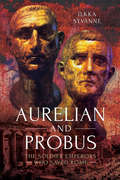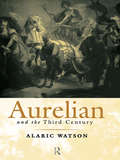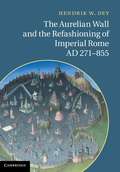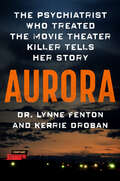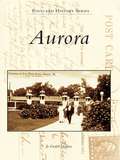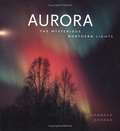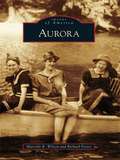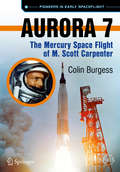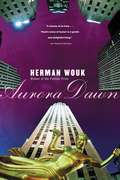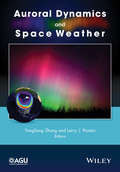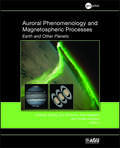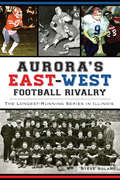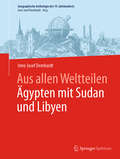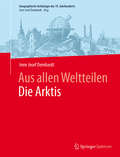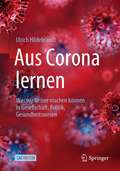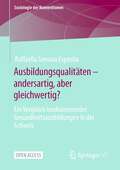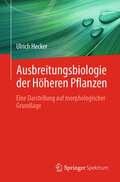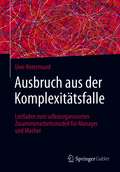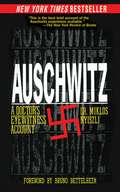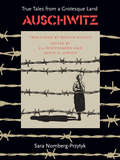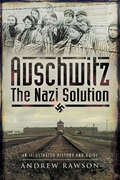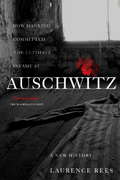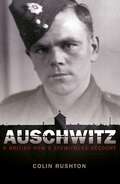- Table View
- List View
Aurelian and Probus: The Soldier Emperors Who Saved Rome
by Ilkka SyvänneAn in-depth military history of the emperors Lucius Domitius Aurelianus and Marcus Aurelius Probus.This is a narrative military history of the emperors Lucius Domitius Aurelianus (“Aurelian,” reigned 270-275) and Marcus Aurelius Probus (276-282) that also includes the other reigns between the years 268 and 285. It shows how these two remarkable emperors were chiefly responsible for the Empire surviving and emerging largely intact from a period of intense crisis. It was Aurelian who first united the breakaway regions, including Zenobia’s Palmyra, and it was Probus who then secured his achievements.The reigns of Aurelian and Probus have been subjected to many studies, but none of these have approached the extant material purely from the point of view of military analysis. Most importantly, the previous historians have not exploited the analytical opportunities provided by the military treatises that describe the strategy and tactics of the period Roman army. It is thanks to this new methodology that Ilkka Syvänne has been able to reconstruct the military campaigns of these two soldier emperors and their other contemporaries in far greater detail than has been possible before.Praise for Aurelian and Probus“A critical work… Aurelian and Probus is a very good look at a very confusing period in Roman history.” —The NYMAS Review
Aurelian and the Third Century (Roman Imperial Biographies)
by Alaric WatsonAurelian and the Third Century provides a re-evaluation, in the light of recent scholarship, of the difficulties facing the Roman empire in the AD 260s and 270s, concentrating upon the reign of the Emperor Aurelian and his part in summoning them. With introduction examining the situation in the mid third century, the book is divided into two parts: * Part 1: deals chronologically with the military and political events of the period from 268 to 276* Part 2: analyzes the other achievements and events of Aurelian's reign and assesses their importance. A key supplement to the study of the Roman Empire.
The Aurelian Wall and the Refashioning of Imperial Rome, AD 271–855
by Hendrik W. DeyThis book explores the relationship between the city of Rome and the Aurelian Wall during the six centuries following its construction in the 270s AD, a period when the city changed and contracted almost beyond recognition, as it evolved from imperial capital into the spiritual center of Western Christendom. The Wall became the single most prominent feature in the urban landscape, a dominating presence which came bodily to incarnate the political, legal, administrative and religious boundaries of urbs Roma, even as it reshaped both the physical contours of the city as a whole and the mental geographies of 'Rome' that prevailed at home and throughout the known world. With the passage of time, the circuit took on a life of its own as the embodiment of Rome's past greatness, a cultural and architectural legacy that dwarfed the quotidian realities of the post-imperial city as much as it shaped them.
Aurora: The Psychiatrist Who Treated the Movie Theater Killer Tells Her Story
by Dr. Lynne Fenton Kerrie DrobanA compelling look at violence and trauma from the psychiatrist who treated mass shooter James Holmes, perpetrator of the infamous movie theater massacre.As an expert and speaker on mass shootings and gun violence, Dr. Lynn Fenton knew it was impossible to &“spot a killer.&” But when she met her new patient, troubled grad student James Holmes, the hair on her arms stood up. She feared he was going to kill. Yet she could find no way to thwart him. A few months later, Holmes struck: he entered a packed movie theater and opened fire, killing twelve people and wounding seventy; some were left brain damaged, several were paralyzed for life. Immediately the familiar debates reignited: The crisis of mental health access. More restrictive gun laws vs more &“good guys with guns.&” The morality of the death penalty. The legitimacy of the insanity defense. But what about the victims and bystanders whose lives would never be the same? Dr. Fenton&’s memoir is a voice for them. Her inability to thwart Holmes&’s mass murder made her a scapegoat and elicited innumerable death threats. Her chilling account provides an intimate look at her life before and after the Aurora massacre, as well as alarming insight into the sinister patient who called himself &“fear incarnate.&” With unprecedented access to thousands of pages of documents, audio and video recordings, trial transcripts, medical records, and notes, Aurora attempts to answer the question Holmes himself posed in his infamous notebook: &“Why? Why? Why?&”
Aurora
by Jo Fredell HigginsCovered wagons brought a wave of migration to northern Illinois in the mid-1830s. On April 1, 1834, the first permanent white settlers, Joseph McCarthy and two assistants, paddled up the Fox River. The vicinity was known as Waubonsie's Village at that time. They built a log cabin, a dam across the Fox, and eventually a sawmill. The village had about 400 Native Americans who bartered fish for bread and tobacco. For almost 175 years now, growth has been steady and sure, and the city of Aurora is the second-largest metropolitan area in Illinois. Aurora is home to honorable civic institutions, excellent education, and a multicultural and energetic population.
Aurora: The Mysterious Northern Lights
by Candace SavageExplore the Myth and Science Behind the Aurora Even those who have not had the privilege of seeing aurora know that there is something magical about them. Throughout the ages, the sheer magnificence and eerie grandeur of the northern lights have evoked both fear and wonder. But few of us understand why or how they occur. As beguiling as the auroral legends are, the scientific explanation for the lights is no less awe-inspiring. In a clear, intelligent text that is accompanied by dozens of archival illustrations, diagrams, and color photographs, Candace Savage explores the myth and science behind the aurora. She reveals the surprisingly common threads in the auroral traditions of distant cultures and follows the long, colorful, and sometimes fractious path that led scientists to the contemporary theory about the lights. Candace Savage is the author of numerous internationally acclaimed books of natural history, including Wolves, Grizzly Bears, Wild Cats and Bird Brains: The Intelligence of Crows, Ravens, Magpies and Jays. Her large body of work has been honored by the American and Canadian Library Associations, the Canadian Science Writers' Association and the Rachel Carson Institute. She lives in Saskatoon, Saskatchewan.
Aurora (Images of America)
by Marcelle R. Wilson Richard FetzerLocated in northeastern Ohio, Aurora began as part of the Connecticut Western Reserve and drew many of its first settlers from New England. The city was founded in 1799, with its residents making their living from hunting, farming, and milling. As settlers cleared the land, planted their crops, and raised their animals, they retained their New England heritage, reflected in the many "century homes" found in the town. The area remained largely rural until the mid-20th century, with dairy farmers shipping cheese all over the country and to Europe from 1850 to 1910. Aurora has served as a bedroom community from the 1900s to the 1960s, and Geauga Lake has been a vacation destination since the 1860s. Currently Aurora retains much of its rural charm with Audubon lands, nature reserves, and many lakes and wetlands.
Aurora 7: The Mercury Space Flight of M. Scott Carpenter (Springer Praxis Books)
by Colin BurgessTO A NATION enthralled by the heroic exploits of the Mercury astronauts, the launch of Lt. Cmdr. Scott Carpenter on NASA's second orbital space flight was a renewed cause for pride, jubilation and celebration. Within hours, that excitement had given way to stunned disbelief and anxiety as shaken broadcasters began preparing the American public for the very real possibility that an American astronaut and his spacecraft may have been lost at sea. In fact, it had been a very close call. Completely out of fuel and forced to manually guide Aurora 7 through the frightening inferno of re-entry, Carpenter brought the Mercury spacecraft down to a safe splashdown in the ocean. In doing so, he controversially overshot the intended landing zone. Despite his efforts, Carpenter's performance on the MA-7 mission was later derided by powerful figures within NASA. He would never fly into space again. Taking temporary leave of NASA, Carpenter participated in the U. S. Navy's pioneering Sealab program. For a record 30 days he lived and worked aboard a pressurized habitat resting on the floor of the ocean, becoming the nation's first astronaut/aquanaut explorer. Following extensive research conducted by noted spaceflight historian Colin Burgess, the drama-filled flight of Aurora 7 is faithfully recounted in this engrossing book, along with the personal recollections of Scott Carpenter and those closest to the actual events.
Aurora Capital Group - Douglas Dynamics
by Birche Fishback Nabil N. El-Hage Blake Gottesman Michael MarinoAurora Capital, a US Private Equity firm, contemplates whether to acquire Douglas Dynamics, the leading US maker of snow plows. Does a business that is highly dependent on the weather, and is seasonal, make a good LBO candidate? This case provides a good introduction to the LBO business. What are the characteristics of a successful LBO? And how do successful PE firms create value by acquiring such companies?
Aurora Dawn: or, The True History of Andrew Reale Containing a Faithful Account of the Great Riot, together with the Complete Texts of Michael Wilde's Oration and Father Stanfield's Sermon
by Herman WoukThe story of the adventures of an ambitious young man in the early days of radio.
Auroral Dynamics and Space Weather
by Larry Paxton Yongliang ZhangThe aurora is the most visible manifestation of the connection of the Earth to the space environment and has inspired awe, curiosity, and scientific inquiry for centuries. Recent advances in observing techniques and modeling and theoretical work have revealed new auroral phenomena, provided a better understanding of auroral dynamics, and have led to an enhanced capability for auroral forecasts. This monograph features discussions of: New auroral phenomena due to the ring current ion and polar rain electron precipitation Various auroral forms and hemispheric asymmetry Auroral model development and MHD simulations Application of the auroral observations for radio absorption and scintillation Aurora nowcast and forecast for space weather operations Auroral Dynamics and Space Weather is a valuable contribution for scientists, researchers, space weather operators, and students of Earth's space environment.
Auroral Phenomenology and Magnetospheric Processes: Earth and Other Planets
by Andreas Keiling Tomas Karlsson Eric Donovan Fran BagenalPublished by the American Geophysical Union as part of the Geophysical Monograph Series, Volume 197.Many of the most basic aspects of the aurora remain unexplained. While in the past terrestrial and planetary auroras have been largely treated in separate books, Auroral Phenomenology and Magnetospheric Processes: Earth and Other Planets takes a holistic approach, treating the aurora as a fundamental process and discussing the phenomenology, physics, and relationship with the respective planetary magnetospheres in one volume. While there are some behaviors common in auroras of the different planets, there are also striking differences that test our basic understanding of auroral processes. The objective, upon which this monograph is focused, is to connect our knowledge of auroral morphology to the physical processes in the magnetosphere that power and structure discrete and diffuse auroras. Understanding this connection will result in a more complete explanation of the aurora and also further the goal of being able to interpret the global auroral distributions as a dynamic map of the magnetosphere. The volume synthesizes five major areas: auroral phenomenology, aurora and ionospheric electrodynamics, discrete auroral acceleration, aurora and magnetospheric dynamics, and comparative planetary aurora. Covering the recent advances in observations, simulation, and theory, this book will serve a broad community of scientists, including graduate students, studying auroras at Mars, Earth, Saturn, and Jupiter. Projected beyond our solar system, it may also be of interest for astronomers who are looking for aurora-active exoplanets.
Aurora's East-West Football Rivalry: The Longest-Running Series in Illinois (Sports)
by Steve SolarzFor over 120 years, the people of Aurora, Illinois, have gathered together to watch East Aurora and West Aurora High Schools square off in what is now Illinois' longest-running football rivalry. Since first taking to the gridiron in 1893, the schools have laid claim to mythical state championships, represented Illinois in intra-sectional games and pioneered night football. Alumni from these storied rivals include college all-Americans, Hall of Fame coaches, decorated war heroes, an Olympic medalist, a charter member of the NFL, numerous successful high school coaches, outstanding businessmen and civic leaders, including former mayors of Santa Monica, California, and Des Moines, Iowa. Author Steve Solarz pored over the records of more than two thousand games to produce a work that is both an encyclopedic resource and a passionate account of a celebrated tradition.
Auroras: Mysterious Lights (Fountas & Pinnell Classroom, Guided Reading Grade 5)
by Laura SalasGHOSTLY LIGHTS IN THE SKY Many stories throughout history have explained the beautiful lights called auroras that dance across the sky. Try to separate fact from fiction as you read about the legends and science of auroras. NIMAC-sourced textbook
Aus allen Weltteilen Ägypten mit Sudan und Libyen
by Imre Josef DemhardtGeographen des 19. und frühen 20. Jahrhunderts sammelten auf ihren Reisen faszinierende Erkenntnisse, die sie in deutschsprachigen wissenschaftlichen Zeitschriften (wie Petermanns Geographische Mitteilungen) umfassend erläuterten. Demhardt interpretiert diese Forschungs aus heutiger Sicht, was war neu, was hat sich bewährt, was wurde umgestoßen an Erkenntnissen. Oftmals ist es erstaunlich, welches Wissen damals bereits vorhanden war und heute vielfach in Vergessenheit geraten ist.
Aus allen Weltteilen Die Arktis (Geographische Anthologie des 19. Jahrhunderts)
by Imre Josef DemhardtGeographische Anthologie des 19. Jahrhunderts Auf den großen Erkundungsfahrten, die im 19. Jahrhundert einen glanzvollen Aufschwung erfahren hatten und maßgeblich an der Etablierung der wissenschaftlichen Disziplin der Geographie beteiligt waren, wurden wissenschaftliche Texte und detaillierte Karten erstellt. Von diesem als ,,geographisches Zeitalter" bezeichneten Jahrhundert gibt es etliche Artikel in geographischen Zeitschriften, die heute zum Teil nur noch schwer aufzufinden oder zugänglich sind. Diesen verborgenen Wissensschatz wieder zu heben, gilt das Interesse der Reihe Geographische Anthologie des 19. Jahrhunderts . Die Autoren bereiten Originaltexte und historisches Kartenmaterial für den modernen Leser durch aktuelle und zeitgemäße Erläuterungen auf und bieten so ein zuweilen vergessenes Panoptikum der Forscherfreudigkeit des 19. Jahrhunderts. Die Arktis, dieses riesige zumeist von Eis bedeckte Gebiet mit dem Nordpol als jahrhundertelangem Sehnsuchtspunkt, war im 19. Jahrhundert das Ziel einer Welle von Expeditionen, die schlussendlich zum Erreichen des Nordpols führten. Die Erkundung der Nordost- wie auch der Nordwestpassage sowie die Entdeckung von Franz-Josef-Land waren weitere bedeutsame Landmarken jener Zeit. Josef Demhardt focussiert sich in diesem Buch auf Auszüge aus dem von Carl Weyprecht in den Mitteilungen der k. k. Geographischen Gesellschaft in Wien verfassten Expeditionsbericht nach Franz-Josef-Land. Die eindrucksvollen Originaltexte, die der Autor kommentiert, nehmen auch den heutigen Leser gefangen und lassen ihn an diesen vergangenen Expeditionen teilhaben.
Aus Corona lernen: Was wir besser machen können in Gesellschaft, Politik, Gesundheitswesen
by Ulrich HildebrandtVon der Krise lernen. Corona zeigt uns, was wir sonst nicht sehen würden.Wer sind die Verlierer und Gewinner? U.a. Restaurants, Hotels, Kulturschaffende und Reiseveranstalter kämpfen ums (wirtschaftliche) Überleben.Menschen, die physisch und psychisch krank werden. Wir suchen Nähe und müssen Abstand einhalten.Wo sind die Fehler im System, z.B.Fehlende Notfallvorräte für Masken, SchutzkleidungFehlende Digitalisierung in Schulen und GesundheitsämternWas können wir selber anders machen, z.B.weniger und hochwertigeres Fleisch essen = bessere Arbeitsbedingungen in fleischverarbeitenden Betrieben = weniger Corona-MasseninfektionenWissenschaftliche Erkenntnisse richtig verstehen und anwenden. Akzeptieren, dass Wissenschaft ein lernendes System ist, das prüft, verwirft und bestätigt.Selbstverständlichkeiten, die wir vielleicht nicht genug zu schätzen wussten, z.B.Offene Grenzen, unbeschwertes ReisenMenschliche Nähe, FeiernWie gehen wir mit Globalisierung um?Es ist kaum zu verhindern, dass aus einer begrenzten Epidemie erneut eine globale Pandemie wird.Was haben wir gelernt?Was können und müssen wir zukünftig besser machen?Corona zwingt uns zu Änderungen. Das nächste Virus kommt bestimmt.
Ausbildungsqualitäten – andersartig, aber gleichwertig?: Ein Vergleich konkurrierender Gesundheitsausbildungen in der Schweiz (Soziologie der Konventionen)
by Raffaella Simona EspositoAm Beispiel zweier konkurrierender allgemein- und berufsbildender Gesundheitsausbildungen - die Fachmittelschule mit Berufsfeld Gesundheit und die berufliche Erstausbildung Fachfrau/-mann Gesundheit - zeigt diese Open Access Studie, wie Qualität von Bildung sozial konstruiert wird. Die Ergebnisse veranschaulichen die Andersartigkeit der Lehr- und Wissenskulturen und tragen damit zur Erklärung ausbildungsprogrammspezifischer Bildungsverläufe sowie stark differierender Übergangsquoten in tertiäre Bildungsgänge bei. Ausgehend davon wird die Frage der Gleichwertigkeit allgemein- und berufsbildender Gesundheitsausbildungen in den Fokus gerückt und die daraus resultierenden Herausforderungen für die Rekrutierung des Fachkräftenachwuchses in verschiedenen Gesundheitsberufen diskutiert. Konzeptionell schlägt die Studie eine neue Perspektive auf die institutionelle Segregation von Allgemein- und Berufsbildung vor. Mit dem theoretischen Originalbeitrag der empirischen Rekonstruktion einer feldspezifischen Ausdifferenzierung der häuslichen Konvention wird das Konzept der Qualitätskonventionen im Hinblick auf den Bedarf einer konventionensoziologisch angeleiteten (Berufs-)Bildungsforschung weiterentwickelt.
Ausbreitungsbiologie der Höheren Pflanzen: Eine Darstellung auf morphologischer Grundlage
by Ulrich HeckerDieses Werk stellt das faszinierende Gebiet der Ausbreitungsbiologie dar, welches neben der Blütenbiologie, botanische und zoologische Verknüpfungen in mannigfacher und komplizierter Weise zeigt. Da Verallgemeinerungen, wie überall im belebten Bereich, ein falsches Bild ergeben, müssen viele Detailergebnisse beschrieben und erläutert werden. ((vorläufig))Wie schaffen es Farn- und Blütenpflanzen, als standortgebundene Lebewesen, sich auszubreiten und neue Lebensräume zu erschließen? Was für Möglichkeiten haben sie? Welche Strategien haben sie im Lauf der Evolution entwickelt? Auf diese Fragen erhalten Sie Antworten. Pflanzen bedienen sich neben Wachstum fremder Hilfe durch Wind und Wasser oder Tiere, um ihren festen Standort zu verlassen. Dabei nutzen sie raffinierte Strategien und andere Lebewesen zu gegenseitigem Nutzen. Sie scheuen sich aber auch nicht, die ihnen dienenden Tiere zu täuschen, zu betrügen oder gar empfindlich zu schädigen. Nur wenigen Pflanzen gelingt es, mit Hilfe des eigenen Turgors, ihre Samen effektiv auszubreiten. Viele Beispiele ausgeklügelter Beziehungen zwischen der Tier- und Pflanzenwelt werden vorgestellt. Erstaunlich ist, dass selbst nah verwandte Arten ganz unterschiedliche Strategien anwenden. Die Ausbreitungsbiologie verbindet Botanik und Zoologie auf faszinierende Weise und offenbart überraschende Einblicke.
Ausbruch aus der Komplexitätsfalle: Leitfaden zum selbstorganisierten Zusammenarbeitsmodell für Manager und Macher
by Uwe RotermundDie klassischen Methoden der hierarchischen Führung sind in der unternehmerischen Praxis der Gegenwart nicht mehr geeignet, die dramatischen Herausforderungen zu bewältigen, vor denen Unternehmen heute stehen. Selbstorganisation und Agilität haben das überkommene „Top-Down-Prinzip“ abgelöst und entfalten eine inspirierende Dynamik in Organisation und Betrieb.Dieses Buch richtet sich an Unternehmer und Organisationsentwickler, die diese dynamischen Kräfte für ihre Organisation entfalten wollen. Es vermittelt ein grundsätzliches Verständnis der aktuellen Herausforderungen für ein zukunftsfähiges Management. Eine Vielzahl praktischer Beispiele aus dem Erfahrungsschatz des Autors mit dem eigenen sowie weiteren Unternehmen helfen Firmen und Managern auf dem Weg zu Selbstbestimmung und Agilität.Der Inhalt- erfolgreich angewandte Organisationssysteme in der heutigen komplexen Welt - Konzepte für Selbstorganisation - Interviews und Best-Practice-Beispiele- Leitfaden für den Transformationsprozess
Auschwitz: A Doctor's Eyewitness Account (Holocaust Handbooks Ser. #Vol. 37)
by Bruno Bettelheim Richard Seaver Tibere Kremer Miklos NyiszliWhen the Nazis invaded Hungary in 1944, they sent virtually the entire Jewish population to Auschwitz. A Jew and a medical doctor, Dr. Miklos Nyiszli was spared from death for a grimmer fate: to perform "scientific research" on his fellow inmates under the supervision of the infamous "Angel of Death": Dr. Josef Mengele. Nyiszli was named Mengele's personal research pathologist. Miraculously, he survived to give this terrifying and sobering account.
Auschwitz
by Sara Nomberg-PrzytykFrom the moment I got to Auschwitz I was completely detached. I disconnected my heart and intellect in an act of self-defense, despair, and hopelessness." With these words Sara Nomberg-Przytyk begins this painful and compelling account of her experiences while imprisoned for two years in the infamous death camp. Writing twenty years after her liberation, she recreates the events of a dark past which, in her own words, would have driven her mad had she tried to relive it sooner. But while she records unimaginable atrocities, she also richly describes the human compassion that stubbornly survived despite the backdrop of camp depersonalization and imminent extermination.Commemorative in spirit and artistic in form, Auschwitz convincingly portrays the paradoxes of human nature in extreme circumstances. With consummate understatement Nomberg-Przytyk describes the behavior of concentration camp inmates as she relentlessly and pitilessly examines her own motives and feelings. In this world unmitigated cruelty coexisted with nobility, rapacity with self-sacrifice, indifference with selfless compassion. This book offers a chilling view of the human drama that existed in Auschwitz.From her portraits of camp personalities, an extraordinary and horrifying profile emerges of Dr. Josef Mengele, whose medical experiments resulted in the slaughter of nearly half a million Jews. Nomberg-Przytyk's job as an attendant in Mengle's hospital allowed her to observe this Angel of Death firsthand and to provide us with the most complete description to date of his monstrous activities.The original Polish manuscript was discovered by Eli Pfefferkorn in 1980 in the Yad Vashem Archive in Jerusalem. Not knowing the fate of the journal's author, Pfefferkorn spent two years searching and finally located Nomberg-Przytyk in Canada. Subsequent interviews revealed the history of the manuscript, the author's background, and brought the journal into perspective.
Auschwitz: The Nazi Solution
by Andrew RawsonThe camps at Auschwitz-Birkenau were an important part of the Nazis' final solution to the Jewish question. Over one million people were murdered in its gas chambers and tens of thousands of prisoners were worked to death in the nearby sub-camps. Others were held in the quarantine area before they were deported to work in the Third Reich.This is the story of the development of Auschwitz from a Polish prison camp into a concentration camp, and a thorough account of the building of Birkenau and the gas chambers, which grew into industrial killing machines. Rawson relates what life was like for prisoners, revealing where the unsuspecting new arrivals came from and how they were greeted at the camp with the humiliating selection process; how many were tricked into entering the gas chambers, while others were stripped of their identity and put to work; how prisoners struggled to survive on a poor diet and no health care; how they faced a grinding daily routine with frequent punishments; and how the camps were organized from the commandants, their assistants and the guards, to the kapos and stuben who supervised work parties and the barracks. He details how a few brave souls tried to resist, how even fewer made a break for freedom and the heartbreaking story of liberation and life afterwards. There are instructions on how to get to nearby Krakow an ideal base and Auschwitz-Birkenau. Information on how best to spend your time there is also included, making this an invaluable book that is both a vivid account of life in the concentration camps and an essential guide for visitors who want to explore the past of this notorious site.
Auschwitz: A New History (Histoire Ser. #Vol. 6015861)
by Laurence ReesPublished for the 60th anniversary of the liberation of Auschwitz?a devastating and surprising account of the most infamous death camp the world has ever known.
Auschwitz: A British POW's Eyewitness Account
by Colin RushtonIn 1942 young soldier Arthur Dodd was taken prisoner by the German Army and transported to Auschwitz. He was forced to do hard labour, starved and savagely beaten. This shocking story sheds new light on the operations at the camp, exposes a hierarchy of prisoner treatment by the SS and presents the largely unknown story of military POWs held there.
